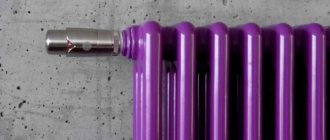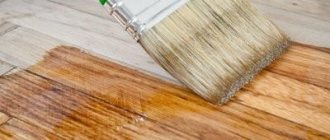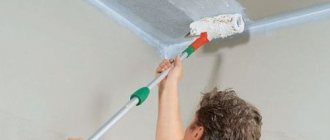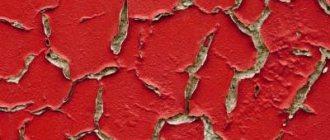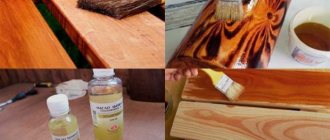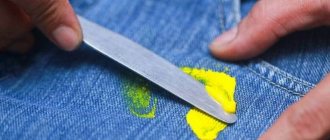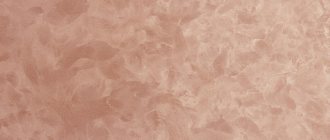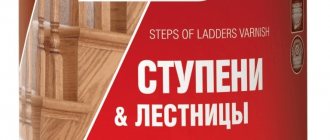Good health to all readers. Today's conversation is dedicated to paint. More specifically, I would like to talk about a problem that I encountered the other day. Having painted the floor in the hallway, I was extremely surprised that the surface remained sticky after a day of exposure. Although this is the maximum period indicated by the manufacturer, after which the layer must completely harden.
Source folksland.net
Be that as it may, you cannot walk on the floor. And I had to urgently look for ways to quickly dry the paint. And at the same time I figured out why such a phenomenon is even possible. And what needs to be done to avoid a similar problem in the future. Or at least quickly speed up the drying process.
Modern quick-drying types of paint
The main characteristic of any emulsion is its drying time.
The drying time depends on the following factors:
Oil paint or varnish dries completely over the course of several days, and a harmful and unpleasant chemical odor is released into the room. If it is not possible to leave your home or workshop, experts recommend using quick-drying materials for home renovation or artistic creation.
The domestic market is represented by a large assortment of quick-drying, odorless paints and enamels. They are made both on water, which quickly evaporates after applying a layer to the surface, and on an organic basis.
The drying process for water-soluble compounds at temperatures up to +7°C is 2-3 times faster than for components in an organic solvent.
There are the following groups of quick-drying water-based emulsions:
- Acrylic. Least harmful to humans. Suitable for painting windows, floors or indoor doors, decorative and artistic works, as they are applied to the surface in even layers and dry for 2-4 hours.
- Water-dispersed. They dry in a matter of hours, are used for interior and exterior decoration and decoration of walls and ceilings, are environmentally friendly, do not peel off, and are permeable to air and water vapor.
In organic solvent:
- Alkyd. Glycerin or pentaerythritol is used as a component. They are applied to wood, metal, and stone to obtain a shiny, durable coating of rich color; they are rarely used for painting. Drying time: 8-10 hours.
- Polyurethane. Drying time is 2 hours; you do not need to wait several days to apply the next layer. A thin film formed on wood, metal or concrete protects the surface from mold, corrosion, the destructive effects of parasites, precipitation and other external factors. The composition is used for interior and exterior decoration. One-component water-based paints on a wooden floor dry up to 5 hours, complete polymerization of the layer ends after 12 hours.
- Oil compositions modified with polyurethane. Dries in 5-6 hours.
- Quick-drying paints include alcohol-acetone based nitro paints. If you spray them from aerosol cans, the first layer will dry in 20 minutes, the second in 1 hour. Nitro paints in liquid form dry more slowly and emit a sharp and strong odor. Due to the high level of toxicity, work is performed only in respirators, otherwise inhaling solvent evaporation will lead to severe chemical poisoning.
How long does acrylic paint take to dry? Can you dry acrylic paint with a hairdryer?
Acrylic paint is a composition based on acrylic binders and colored pigments. It comes in a variety of colors, coverage levels, light fastness and gloss. Widely used by artists and decorators in painting, decoupage, scrapbooking and painting. It dries quickly, which is a big plus when compared with oil paints. After drying, it forms a durable elastic film that is indelible with water (which cannot be said about watercolor and gouache paints!). Acrylic is a water-based, non-toxic paint, ideal for children's creativity.
Drying time averages from 30 minutes to 2 hours (depending on the thickness of the applied layer).
Blow drying is ideal and acceptable
as part of live master classes, when the time to complete the entire work is strictly limited. But not with a hot air stream and at a distance of at least 30 cm from the work.
Not recommended
use a hair dryer if you are doing acrylic painting. If you want to get a durable canvas, leave it to dry naturally! True, given the ability of acrylic paints to dry quickly, painters do not have any problems. On the contrary, they often resort to special mediums that slow down the drying of acrylic paints.
How to speed up paint drying time?
Oil emulsions take a long time to dry, up to 40 hours. In order to speed up the drying of the paint, a special catalyst-drier is added to the product before painting. The substance is introduced into the main product to increase the rate of polymerization of vegetable oils.
Compounds of transition and non-transition metals, as well as metal-containing components: salts of Co, Mn, Pb, K, Ca and others act as drying agents. The composition with a drying accelerator dries within 22-28 hours.
In painting, experts do not recommend adding a drier to the oil: the substance has a negative effect on the paint layer and causes darkening. In addition, the paint pigments also lose their original color.
Proper application as a way to speed up the drying process of paint
When painting any surface, you need to know why the paint takes a long time to dry. The gradual application of thin layers leads to faster drying of the coloring solution than the application of 1 thick layer. The oil coating is applied with a brush or roller.
If the surface becomes translucent, the procedure is repeated every other day. If a wall or other coating is being processed outside the room, in warm weather the paint dries within 4-5 hours, inside the room - in 20-24 hours.
To reduce drying time, the paint can be sprayed with a spray gun. Oil, varnish or enamel is applied to the surface to be treated in a thin and even layer; the product must be preheated.
Compliance with technology
Let's look at how you can quickly dry oil paint when working on your own. And for this we will listen to the professionals. And they say that the drying time of the surface directly depends on the thickness of the applied layer.
Source sostav.ru
Factors affecting the quality of the coating:
- It is impossible to apply the same pressure on the hand all the time. Therefore, much more paint is consumed than it should be, and the thickness of the application is significantly overestimated.
- The roller allows you to apply a thinner and more uniform layer. Therefore, the drying time at the surface at any point will be the same.
- A thinner layer can only be achieved when using a spray gun or an aerosol can.
By applying these tips and combining them with techniques to speed up drying, you can get great results. In some cases, the surface will be hard after 5 hours. But even the most capricious materials will not take more than one day to repair.
Source gidpokraske.ru
What helps paint dry quickly?
If construction ends with finishing work - painting, then the renovation of a house or apartment is just beginning. The area of painting varies; it may include painting the floor, ceiling and walls, or it may be limited to one contrasting wall or only the floors. Naturally, while the paint is drying, you cannot use the painted surface, much less stay indoors. Therefore, many people have a question about how to quickly dry paint.
Using additional heat
Let's look at how you can quickly dry oil paint by raising the temperature in the room. After all, it has been proven that already at plus 10 °C the evaporation of any liquid completely stops. And the higher the temperature of the surrounding atmosphere, the more intense the steam leaves the room.
Professionals use special heat guns. But they are used on an industrial scale. It is better to install a regular heat fan in the apartment. It will allow you to combine two positive effects at once. And the temperature in the room will increase and create forced air circulation.
Source mircli.ru
Separately, you can consider using an infrared heater. It has one interesting feature. It warms not only the air, but also the surrounding objects. Therefore, if you install a similar heating device in the center of the floor to be painted, then soon the surface itself will help dry the paint faster.
But when using this method, the main thing is not to overdo it. If the temperature in the room increases significantly, this may cause cracks to appear on the surface with paint. Therefore, you must carefully read the conditions on the packaging. And do not exceed the temperature indicated there.
What should you pay attention to?
Before you begin painting work, you should pay attention to several factors:
- First of all, the expiration dates of the paint, which must be indicated on the can.
- Instructions for use and dilution must be read clearly and in understandable language.
- Before use, the paint must be stirred most thoroughly, checking to see if there are any thickened components left at the bottom.
- The surface must be cleaned, degreased and primed.
- What is difficult to check is the storage conditions. When oil paint freezes, it can separate even after thorough mixing and lose its properties. But here the calculation is only on the conscience of the seller.
General recommendations when working with acrylic primers, paints and other compounds
Before you start work, no matter what exactly you are doing: painting, decoupage, scrapbooking, carefully read
the information from the manufacturer of
the material. It is usually indicated on the label. This includes the shelf life of the material, its purpose/application (for which surfaces it is suitable, recommended drying time, consumption) and so on. Do not work with expired materials. And, of course, you shouldn’t work on a metal surface with fabric primer either. Acrylic materials are considered quite universal, but it is better to take what is suitable for the specified surface: there are still nuances and differences.
Be careful! Choose the right compounds suitable for your surface.
By the way, drying time also directly depends on the surface on which you are working. Porous and absorbent surfaces (paper, cardboard, wood, fabric, etc.) dry much faster than metal, glass and plastic. The latter have a very smooth surface, so materials applied to them dry only due to surface evaporation of moisture.
The problem with paint taking a long time to dry
Oil-based floor paint based on drying oil is rarely used nowadays, more often glossy varnishes based on alkyd-urethane resins with targeted additives and various solvents are used. This parquet varnish will easily adhere not only to wood (parquet, boards, chipboard or cork), but also to concrete or metal.
However, the drying time for the second layer of varnish (and at least 2-3 layers will be needed) will be 8-10 hours, the third layer will take at least 24 hours. The floor itself can be “put into operation” no earlier than in a few days: even a slight touch to the varnish surface before it has completely dried can damage its mirror-like smoothness.
Lacquer paint does not dry as quickly as we would like. And the smell! Not only is the smell pungent and unpleasant, it is also very harmful to health!
So that floor paint or paint for walls and ceilings does not disappoint you, and repairs remain in your memory as a troublesome but pleasant event, it is worth understanding the properties and features of the product you have chosen.
Reasons why paint takes a long time to dry
Throughout the centuries, oil paint based on drying oil has had the longest hardness development. It still has one of the very long drying times. But in fact, materials based on this are rarely used anymore. Because paints with much better characteristics have already been developed. And their price is not much higher than outdated products.
The paint, which consists of a water dispersion, dries quickly. But it is not suitable for all surfaces. Well, at least the floor is not covered with such a composition. Record drying speed for nitro paint. But its peculiarity is that the surface no longer sticks, and the smell lingers in the room for a long time. Moreover, the fumes are extremely toxic, and they are easily absorbed into surrounding objects.
Today, the most popular are glossy varnishes, the base of which consists of alkyd and urethane resins. And various additives and solvents make them unique or universal. And not only wood, but also metals, as well as any concrete coating, are successfully processed with similar compounds.
Source parketista.ru
Manufacturers claim a high drying speed for such paint. The packaging indicates that the layer hardens within 8-10 hours after application. However, everything turned out to be not as rosy as they are trying to portray to us. The fact is that for a better look, the surface must have at least two layers of coating. And in some cases three.
Each subsequent layer has a longer curing time than indicated on the packaging. For example, the second layer dries for at least 24 hours. And if the surface is covered with a third layer, then full use of the floors is possible only after a few days, so that the gloss can fully take hold. And now the question arises of how to quickly dry the paint, since not everyone has that much time to wait for a brilliant result.
But the reasons for the long hardening of the surface may be hidden not only in paint compositions and coating technologies. The buyer must be careful when purchasing material. And if he himself is going to use it, then he should know some of the nuances.
Source gidpokraske.ru
The main reasons why paint cannot dry quickly:
- The material may already have expired.
- Storage conditions before sale may have been violated.
- The paint was not thoroughly mixed before use.
- The surface was not pre-treated (cleaning, degreasing, priming).
- Temperature conditions were violated.
Storage conditions cannot be verified. But the implementation of the remaining points is already on the conscience of the buyer and the performer of the work. For example, if in a room the air temperature at the surface is close to zero, then the paint on such a field may not dry at all.
Properties and features of modern paints
The modern market can offer many color options, but there are actually not so many types of paints, or rather their groups.
Quick-drying, water-based
These water-soluble dispersion paints dry in a matter of hours. They are readily used for both external and internal work; they are used to paint both concrete and brick with plaster. Such materials also have an advantage over other types of paints - environmental friendliness, because... they do not contain an organic solvent.
After drying, water-emulsion and water-dispersed mixtures do not form a dense vapor-proof film, which means that the walls and ceilings will “breathe.”
“Breathing” quick-drying coatings include not only water-based paint, but also latex, wallpaper and modern acrylic paint and enamel, the use of which produces quick and high-quality results.
Alkyd compositions
They are divided into phenolic, urethane, glypthal and pentaphthalic. The composition includes 5 main components:
- solvent solvent (turpentine or white spirit);
- filler (chalk or microtalc);
- functional additives – driers;
- red lead or ocher pigments, titanium white, etc.;
- varnish
Such paints are convenient and easy to apply to the surface; they are also suitable for any type of finishing, decorative and artistic work. The drying time of paint or varnish of this group is significantly reduced, however, such compositions still dry longer than acrylic water-dispersed emulsions.
If the composition contains specific-smelling solvents, it is still not recommended to use alkyd enamels indoors.
Oil paints
Repair and construction oil paints have the same composition of inorganic pigments, combined, alkyd drying oils and fillers as artistic oil paints that we see on the artist’s canvas (picture). You must not touch fresh canvases! Why? Because paints recently applied to canvas, and even in several layers, are easily deformed. The layers of paint need to dry thoroughly before the painting can be presented to the audience and critical judgement.
How long does oil paint take to dry? A very long time! She is generally a candidate for the title of champion in the “Paint Won’t Dry” category. And this is on the artist’s easel! What to do if the walls or floors of the house are covered with an oil-drying oil mixture? Luckily, there are options to speed up the drying of the sticky thick layer. Let's look at them below.
On video: how to choose paint.
How to speed up the drying process of paint?
Option 1
A special catalyst will help speed up the drying of oil paint. This product is called a desiccant. It is sold in the paint and varnish departments of construction stores. The drier is an accelerating element for polymerization, that is, its purpose is to ensure that the drying process does not take too long.
Salts of cobalt, manganese and calcium can be used as catalysts-accelerators-driers. Lead, zirconium and barium salts are often used. Salts of carboxylic acids are an ideal solution, although the modern market increasingly offers multi-metal mixed dryers that can be used for several types of paintwork materials and do not in any way affect their color and adhesive properties if you follow the included instructions.
The appendix will tell you how much drier you need to add per 1 liter so that the paint does not “curl” when applied, but simply dries faster. After using such an accelerator, difficult-to-dry oil compositions obediently polymerize. How long does it take for paint with drier to dry? Typically within 24-28 hours at room temperature.
You need to take care of the acceleration before applying the first layer, that is, you need to add the drier directly to the paint before painting, otherwise the trick will not work.
Option 2
How to quickly dry oil paint if the catalyst application time has been missed and 2-3 layers of paint are already on the wall? I would like to believe that the layers are thin enough. If you prefer a spray gun to a roller or brush, which under pressure produces an even, thin, smooth layer, and the paint is distributed over a heated surface, then the drying time is significantly reduced.
A cold wall for oil paint is a bad option. In the cold, the butter hardens, spreads poorly (think of a sandwich) and, accordingly, dries with difficulty.
Option 3
What else can you do to make the paint dry faster? Raise the temperature! High temperature is another catalyst to make the paint harden faster. At industrial facilities they use a heat gun, but for us a hair dryer or a regular infrared heater is enough. With this we will “kill two birds with one stone”: we will raise the temperature inside the room and lower the humidity.
Lack of moisture and heated air contribute to the rapid release of solvent from paint layers (oil paints do not have their own water), so the film formed during drying becomes dense and hard - it has dried out!
Option 4
When the solvent evaporates, many odorous harmful substances are released, so many people advise creating a draft in the room. Ventilation will not only remove unhealthy fumes, but will also promote quick drying. Therefore, we open the doors and windows, turn on the fan, and place the heater in the middle of the room, in no case close to the wall.
The infrared waves of the heater must penetrate through the resulting film and oil base evenly, and also evenly heat the wall underneath. However, make sure that the temperature does not rise above 60 degrees, otherwise the “boiled” paint will simply burst and crack. This is definitely not our option!
Advice! When the paint has dried, wipe the fresh surface with a soft cloth soaked in a solution of vinegar or ammonia, then it will not “stick” and will acquire a pleasant shine.
On any composition (on the packaging) you can read that it must be thoroughly mixed before use - if you neglect this instruction, the binding components may remain at the bottom, making the coating incomplete.
It is also very important that the surface to be treated is dry and free of oil and grease stains, which can directly affect the drying time of the paint. Another reason for prolonged drying may be a violation of storage conditions - all paints have a critical negative temperature. Perhaps the composition you purchased simply froze, losing its properties.
Special Additives
Various catalysts are added to some types of paint. They are also called driers. They can significantly accelerate the polymerization of the base composition.
Dryers can consist of various salts:
- manganese;
- cobalt;
- calcium;
- lead;
- barium;
- zirconium.
The best substances are those based on salts of carboxylic acids. It is the latter that act as a lifesaver when the acute question arises of how to quickly dry oil paint. And the addition of such additives allows you to expect a successful result within a day.
Source kraskaok.ru
Dryers can be mixed and used for different types of paint. They are added before stirring, but the proportions must be strictly observed. Otherwise, there is a danger that the paint may curl.
Types and features of paints
On the market among construction products you can find no more than four groups of paints:
- Oil and alkyd.
- Water-soluble, water-emulsion, water-dispersed.
- Specialty products regardless of the basis.
- For decorative coating.
Paints that dissolve with water can be used for external and internal work and can be used to treat concrete, brick, and plaster surfaces. Their advantage is environmental friendliness, because they do not contain organic solvents, and such a surface will allow air to pass through, since a vapor-proof film will not form. This group of paints is produced on the basis of polyvinyl acetate, styrene butadiene and acrylic dispersions.
Oil dyes are also used indoors and outdoors; they paint and protect wood and metal. They form a strong vapor-proof film on the painted material, that is, it is fire and toxic.
There are four types of paints in total
Special coloring agents have been developed to protect wood from fungi and mold and those that impart water-repellent properties to the surface.
The decorative group serves to hide errors or small irregularities in the building material being painted.
Which paint dries faster?
We always use paint when we repair or re-build something, because we cannot do without painting surfaces. Almost all dyes have a characteristic, pronounced odor. And we all want to get rid of it as soon as possible. And to achieve the desired result, you need to dry the paint quickly. If the paint is oil-based, you will have to work hard to make it dry quickly. The best way is to replace it with water-soluble or alkyd. It dries quickly and will not cause any inconvenience when using it. Well, if this option is not suitable, you should find out all the ways to dry the paint.
Accelerating paint drying using catalysts
If you need the paint to dry as quickly as possible, then you should use a catalyst. This substance is sold in all hardware stores, warehouses and supermarkets. Before purchasing or using, please read the instructions carefully. It describes how to use the product and how much to add per liter of paint (or other dosage) to speed up the process as much as possible.
But this option is only suitable if the paint has not yet been applied to the surface. Oil paints contain more than a dozen components, which is why drying accelerators should be used. The second option would be to use quick-drying paints. Today there are dyes on sale that are dry after two hours and do not emit a characteristic odor. Their price is higher, but if the result is important, then it is worth buying quick-drying coatings, which are mainly used indoors, where air exchange is poor and the result must be quick. These include water-based, latex and modern acrylic.
We use improvised means
There are several options for drying paint using improvised means:
- Oil paint contains no water, so when it dries, a film forms and becomes hard. The first thing to do is to provide fresh air. If natural air exchange is not enough, you should open the window and leave it in this state for a while. The ideal option would be to create a draft and also open the doors.
- The catalyst for the oxidation process is temperature. If you place a heat source in the room, the paint will dry faster. In industry, a heat gun is used. If you apply the dye in cold weather, it will begin to thicken and it will be difficult to apply it in an even or thin layer. Therefore, before starting work, you should warm up the room.
- The drying time of the paint directly depends on the thickness of the layer, that is, the smaller the layer, the faster it dries. Give preference to a spray gun rather than a brush or roller. If you paint the outside of the room with a thin layer, then in warm weather the paint will harden within a few hours, and inside the room it will take about a day. For this purpose, you can also heat a thick layer using an infrared heater. Infrared rays pass through the formed film and evenly heat the inner and top layers.
- Humidity can speed up or slow down the polymerization process. Thus, low humidity accelerates it, so sources that increase the humidity in the room should be removed from the room.
- If you need to dry small items, you can place them closer to a heat source, for example, near a radiator or stove, but make sure that the temperature is no higher than 60 degrees Celsius. After all, being very close and heating up sharply, the paint bursts and all the work is zero.
These practical tips will help you and, after trying once, you will use them constantly when the need arises. With their help, you can get rid of the pungent odor characteristic of paint and speed up the completion of repairs. Use available materials, chemicals and the “tricks” of experienced craftsmen, and let your home always be comfortable and cozy, regardless of repair work.
Air circulation
The drying process is directly related to evaporation ability. The faster the coating composition gets rid of excess moisture that is present in any of the solvents, the sooner the layer will harden. Therefore, it is necessary to create optimal conditions in the room.
In the simplest version, all doors and windows in the room open. After all, in a closed room the humidity immediately begins to rise. A steam cloud over a painted surface can significantly slow down the evaporation of moisture from the paint. But the method is only suitable for the warm season.
Source posudamart.ru
If you create such a draft in winter, the air temperature at the surface will sharply drop to critical. And the steam emission will stop altogether. Therefore, in most cases it is better to use a regular fan. It will create a forced air flow that will not allow evaporation to accumulate in one place.
Rules for using acrylic paints
Paints based on acrylate polymers are widely used in repair, painting and artistic design work. They are safe, easy to use, and create a water-resistant layer. To obtain the desired results, you should know the basics of what acrylic paints are, how to use them, how long they take to dry, and other nuances of the work.
Variety of acrylic paints.
Features of acrylic compositions
This paint is a water-acrylic dispersion. It does not contain harmful impurities, has no pungent odor, and does not emit caustic fumes either during application or after drying. To dilute the liquid paint material, purified water is used; professional artistic compositions in some cases require the use of a special diluent.
The dried layer retains elasticity, does not crack or crumble. It is not washed off with water and does not absorb dirt particles, but remains permeable to air and water vapor.
Other paint features:
- wide range of colors, possibility of independent tinting;
- ease of application;
- high level of adhesion;
- the ability to create smooth and textured surfaces;
- good hiding power, which ensures economical consumption;
- speed of hardening;
- resistance of the finished coating to abrasion, dampness, UV rays (does not fade), and many solvents;
- fresh stains are easily wiped off, tools are cleaned with water.
Acrylic paints: how to use
Acrylic is versatile, but the possibility of using the selected variety on the existing type of surface should be clarified. The material must be mixed before use. It can be applied with a brush, roller, palette knife or by spraying. 1-2 layers are enough, re-painting is carried out after the coating has completely dried.
The acrylic composition is diluted with water:
- when using it as a primer;
- to reduce hiding power, reduce consumption;
- if it has thickened due to prolonged storage;
- in hot weather to slow down drying;
- before applying with a spray gun or airbrush.
Acrylic paints for painting on canvas.
The water should be cool. When painting, it is best to use a wet palette, which is wax paper placed on top of a dampened watercolor sheet. On a plastic palette, paint thickens quickly. To slow down the process, you will have to irrigate it with a sprayer every 10-15 minutes.
When changing from one tone to another, rinse the brush with water, then blot it with a rag or napkin. If you need to mix colors, you need to act quickly. If you do this on paper, it is better to moisten it first, although the technique of drawing on a wet sheet when working with acrylic is difficult.
A fresh layer can be applied to a dried acrylic film without the risk of smearing the previous one. To obtain clear delineations and sharp corners, use masking tape. The edges of the glued strips should fit tightly to the substrate; paint should not be applied in these places too quickly.
To protect finished elements from accidental staining, they are treated with a masking liquid. Work should continue after it has completely dried.
Tools should be washed immediately after finishing work. If the paint has dried, it will be difficult to clean them, since dry acrylate can only be removed with a special solvent. Store painting materials tightly closed.
How long does acrylic paint take to dry and can it be dried with a hairdryer?
The speed at which it dries depends on the following factors:
- Acrylic quality.
- The degree of its dilution (the amount of water in it).
- Layer thickness.
- Absorbency of the substrate.
- Ambient temperature and humidity.
The approximate time is indicated on the label. On average, 2-3 hours are enough for drying, after which you can apply the next layer. When the material is thinly distributed on a smooth surface, the process takes 20-30 minutes. It takes about 24 hours to dry completely. At this time, rough mechanical impact on the coating should be avoided, as there is a high probability of damage.
It is not advisable to resort to blow drying.
For acrylic paint, the drying process consists not only of complete evaporation of moisture, but also of the final polymerization of the material, as a result of which a solid and durable polymer film is formed. Raising the air temperature and ventilating the room helps speed up drying.
You can quickly dry the painted surface with a household hairdryer. This is not the best option and should be used only when absolutely necessary. The coating is carefully blown with a moderately warm stream, periodically switching to cold air. In this case, the hairdryer must be placed at some distance from the surface (30 cm or more). With powerful blowing, you can get sagging, overheating leads to a decrease in adhesion, and deformation of some types of base (for example, plastic) is possible.
In relief elements, which are obtained by painting with textured strokes or using an acrylic contour, only the top layer is set under the influence of heated air. Beneath it there is an unfrozen mass. This must be taken into account during further work so as not to accidentally damage the thin film and spoil the composition.
In painting, the relatively high drying speed of paint creates some difficulties. Therefore, many craftsmen use a drying retardant. It is indispensable when you need to get a smooth transition between tones, add shadows or perform soft shading. This additive does not affect the basic properties of the dispersion, but makes it easier to apply, increases spreadability, and makes the color a little brighter. The volume of retarder should not exceed 25% of the original amount of material.
Comparison table: how long do different types of paints take to dry.
How long does acrylic paint take to dry? How to dry with a hairdryer?
The issue of proper drying (including with a hairdryer) is very relevant among novice artists and decorators. Each material has its own characteristics, scope and purpose. And in order to correctly answer the question of whether to dry with a hairdryer or not, you need to clearly understand the materials and compositions used.
In order not to get overwhelmed, today we’ll talk about the most common materials for creativity: acrylic primer, paint and contours.
